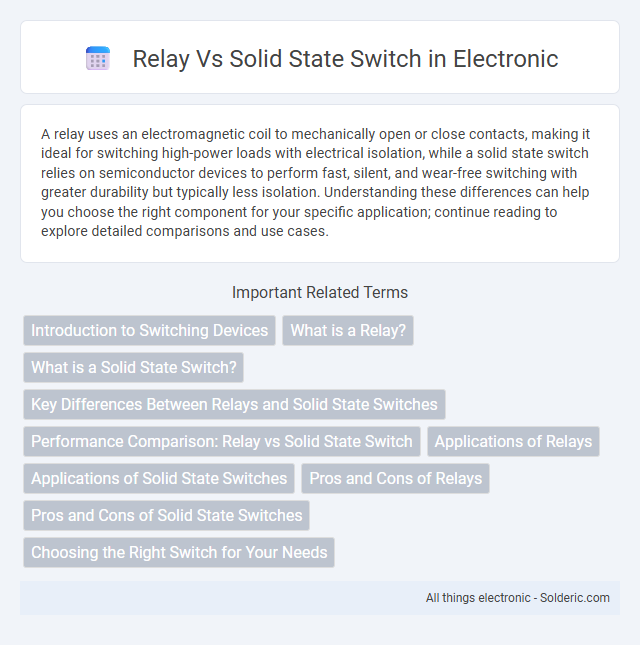A relay uses an electromagnetic coil to mechanically open or close contacts, making it ideal for switching high-power loads with electrical isolation, while a solid state switch relies on semiconductor devices to perform fast, silent, and wear-free switching with greater durability but typically less isolation. Understanding these differences can help you choose the right component for your specific application; continue reading to explore detailed comparisons and use cases.
Comparison Table
| Feature | Relay | Solid State Switch |
|---|---|---|
| Operating Principle | Electromechanical switching | Electronic switching using semiconductor devices |
| Switching Speed | Slow (milliseconds) | Fast (microseconds to milliseconds) |
| Durability | Limited mechanical lifespan (10^5 to 10^7 cycles) | High lifespan (10^7 to 10^9 cycles) |
| Noise | Audible clicking noise | Silent operation |
| Power Consumption | Requires coil power to maintain state | Low power consumption |
| Size | Generally larger | Compact and lightweight |
| Contact Type | Physical contacts (subject to wear) | No physical contacts (semiconductor-based) |
| Applications | High current switching, isolation needed | Fast switching, silent operation, low voltage control |
| Cost | Lower initial cost | Higher initial cost but lower maintenance |
Introduction to Switching Devices
Switching devices are essential components in electrical circuits, enabling the control of power flow to various loads. Relays use electromagnetic coils to mechanically open or close contacts, providing physical isolation and suitability for high-power applications. Solid state switches, such as transistors and thyristors, offer faster switching speeds, longer lifespan, and quieter operation by utilizing semiconductor technology without moving parts.
What is a Relay?
A relay is an electromechanical switch that uses an electromagnetic coil to open or close contacts, controlling high voltage circuits with a low voltage signal. It provides electrical isolation between the control circuit and the load, making it ideal for switching heavy currents safely. Your choice of a relay ensures reliable operation in applications requiring physical contact separation and protection from voltage spikes.
What is a Solid State Switch?
A solid state switch is an electronic switching device that controls electrical power without moving parts, using semiconductor components like transistors or thyristors. It offers faster switching speeds, greater reliability, and longer lifespan compared to mechanical relays. Solid state switches reduce electrical noise and are ideal for applications requiring frequent switching and precise control.
Key Differences Between Relays and Solid State Switches
Relays use electromagnetic coils to mechanically open or close contacts, offering isolation and suitability for switching high voltages and currents with slower response times, while solid state switches operate electronically with semiconductor components, providing faster switching speeds and greater durability due to the absence of moving parts. You should consider that relays are better for applications requiring electrical isolation and handling inductive loads, whereas solid state switches excel in high-speed, high-frequency switching and longer operational lifespans. Key differences include mechanical versus electronic operation, switching speed, noise generation, and lifespan, impacting their performance in various control systems.
Performance Comparison: Relay vs Solid State Switch
Relays offer mechanical switching with slower response times typically around 5 to 20 milliseconds, making them suitable for applications requiring physical isolation and high current capacity. Solid state switches provide faster switching speeds in the microsecond range, enhanced reliability due to no moving parts, and longer lifespan under high-frequency operations. Your choice between relay and solid state switch depends on whether priority is given to mechanical durability and isolation or to speed and silent, wear-free switching performance.
Applications of Relays
Relays are widely used in applications requiring electrical isolation and switching of high-power circuits such as automotive systems, industrial automation, and home appliances. Their ability to handle high inrush currents and provide reliable mechanical switching makes them ideal for motor control, lighting circuits, and safety interlocks. You benefit from relays when your application demands robust switching with clear physical separation between control and load circuits.
Applications of Solid State Switches
Solid state switches excel in applications requiring high-speed switching, such as in telecommunications, industrial automation, and power electronics. Their ability to handle frequent on-off cycles without mechanical wear makes them ideal for motor controls, lighting systems, and temperature regulation. Solid state switches also provide silent operation and increased reliability, benefiting sensitive electronic devices and complex control systems.
Pros and Cons of Relays
Relays offer strong electrical isolation and can handle high voltages and currents, making them ideal for heavy-duty applications. However, their mechanical components lead to slower switching speeds, shorter lifespan, and increased wear and noise compared to solid-state switches. You should consider relays for reliable, high-power switching but be aware of potential durability and speed limitations.
Pros and Cons of Solid State Switches
Solid state switches offer rapid switching speeds and longer operational life due to the absence of mechanical parts, making them ideal for high-frequency applications. They provide silent operation and enhanced resistance to shock and vibration, but their higher initial cost and potential heat dissipation issues require careful thermal management. Unlike mechanical relays, solid state switches have limited tolerance to voltage spikes and may exhibit leakage current when off, which can affect sensitive circuits.
Choosing the Right Switch for Your Needs
Choosing the right switch between a relay and a solid-state switch depends on factors such as load type, switching speed, and durability requirements. Relays are ideal for high-voltage applications and provide complete electrical isolation but have slower switching speeds and mechanical wear issues. Solid-state switches excel in fast switching, silent operation, and long lifespan, making them suitable for low-voltage, high-frequency applications where reliability and noise reduction are critical.
relay vs solid state switch Infographic

 solderic.com
solderic.com